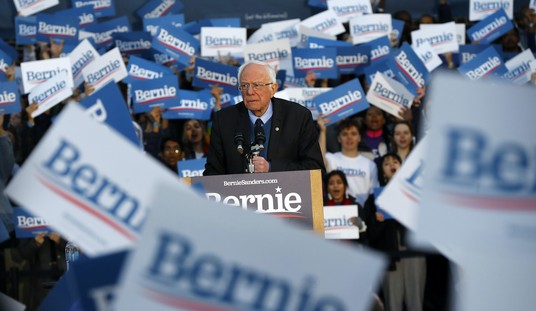We wondered whether the mainstream media would start connecting the dots on Solyndra and Barack Obama’s failed “green jobs” stimulus. ABC News has done a great job reporting on the scandal itself, including its connection to an Obama campaign bundler and the remarkable manner in which taxpayer funds were subordinated to George Kaiser’s investment by the Department of Energy — in direct contravention of Congressional mandates protecting taxpayer-funded loan guarantees. The first major media outlet to view Solyndra in the larger context of stimulus failure turns out to be Newsweek — and Eleanor Clift, surprisingly (via Instapundit):
Washington’s scandal du jour has been Solyndra. The California solar company received a rushed half-billion-dollar clean-energy stimulus loan from the Obama administration, only to go bankrupt and potentially leave taxpayers on the hook—despite warnings from career officials that both Solyndra and the larger solar industry were facing financial pressures.
But it is far from the only blemish on the administration’s much-touted green agenda. In addition to weatherization problems, an internal Labor Department report disclosed this month that a multibillion-dollar program to retrain workers for green-energy jobs met only 10 percent of its goal of creating 80,000 jobs. A federal renewable-energy lab in Colorado that got nearly $300 million from another green-energy program began laying off 10 percent of its workforce last month.
Overall, as the $787 billion economic stimulus—the primary engine for the green-energy agenda—came to an end Sept. 30, it is clear that the program created far fewer jobs than promised. So-called green-collar jobs are notoriously hard to tally, but numerous estimates by gleeful Republicans put the taxpayer cost of each green-energy job created by the stimulus at more than $1 million.
The article is titled “Obama’s Big Green Mess,” but the URL indicates that it originally went by another title: “Obama’s Green Energy Agenda Flop.” That doesn’t mean that Newsweek allowed itself to focus on Obama’s role in the flop, however, or the role his crony capitalism played — at least not explicitly. Clift scolds Republicans and Democrats alike for turning both the solar and oil industries into pay-for-play arenas, but curiously doesn’t mention Kaiser or his role as both bundler for Obama and the highly favorable and questionable treatment he received from DoE.
Clift also tells an anecdote to push some of the blame off onto Energy Secretary Stephen Chu, but doesn’t realize that the report actually makes Obama look like a dilettante:
Internally, some have questioned Energy Secretary Steven Chu’s role in overseeing the efforts, noting that the Nobel laureate with the keen grasp of physics at times seems to lack political skills. On one occasion, Chu prepared a dense PowerPoint presentation to brief Obama on the complexities of last summer’s BP oil spill. After Chu narrated six slides, one senior adviser who attended the meeting recalled that Obama simply stood up and said, “Steve, I’m done.”
Really? We had a severe environmental disaster unfold in the Gulf, and Obama couldn’t bother to sit through more than six Power Point slides to cover the material? That actually provides a great insight into why Obama chose to push his “green jobs” stimulus, despite decades of failure of federal subsidies to produce a viable, mass-producing solar and wind industry in the US. Obama doesn’t bother to do his homework; he merely dusted off decades of liberal hobby horses and just figured they would work as advertised. When it comes to the hard work of analysis and creative thought, Obama’s limit is apparently six Power Point slides.
At least this moves the ball forward, if only incrementally.
Update: Count the Economist out of the subsidy-cheerleading business, too:
THE rush to subsidise solar power over the past decade has been massively wasteful and squalidly political. Nowhere is this more obvious than in the sorry saga of Solyndra, a Californian maker of novel tubular solar panels down the maw of which the Obama administration shovelled $535m in the hope of “green jobs” and photo ops. It got instead mismanagement, bankruptcy and scandal. The money wasted on Solyndra, though, is as nothing compared to the tens of billions of euros squandered on solar panels in Germany. So little electricity do these panels produce under its cloudy northern skies that the emissions from a single large coal-fired power station are enough to nullify all the benefits that their carbon-free contribution might bring. The green jobs they, too, were meant to bring are largely, though not entirely, in China. …
There is much that governments can do to encourage such progress in the future without repeating the mistakes of the past. They should limit the grounds on which people can object to neighbours’ solar installations through the planning process. They should remove subsidies for technologies that compete with solar. In India, which has lots of sun and lots of back-up generators burning subsidised diesel, that could be a game changer in itself. Above all they must fix a price of carbon that gives innovators the confidence that competing with fossil fuels for the long term will be a rewarding, and perhaps hugely profitable, undertaking. If politics prevent them from setting a substantial carbon price, they might consider requiring utilities to have a carbon-free component to their generating portfolios, as happens in many American states. But that needs to be open to all carbon-free technologies, not just the ones that the politicians like, so that the most efficient can prosper.
You mean that having politicians pick winners and losers (really, just losers) doesn’t create efficiency and innovation? I’d be shocked … if I wasn’t paying attention to the decades of futility we have seen in green-tech subsidies in the US.








Join the conversation as a VIP Member